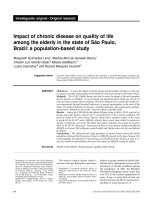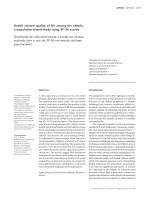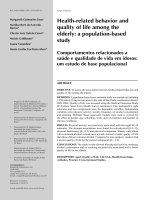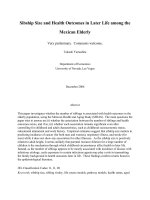4 1 life among the chumash
Bạn đang xem bản rút gọn của tài liệu. Xem và tải ngay bản đầy đủ của tài liệu tại đây (2.89 MB, 10 trang )
Fascinating Facts
• Chumash people used fishhooks hundreds of
years ago.
• The Chumash paddled their canoes so far out in
the ocean that sometimes they lost sight of land.
• Chumash hunters used wooden decoys to
hunt ducks.
Genre
Nonfiction
Comprehension Skill
Text Features
Main Idea and Details • Map
• Sidebars
Scott Foresman Social Studies
ISBN 0-328-14854-7
ì<(sk$m)=beifeh< +^-Ä-U-Ä-U
by Stephanie Sigue
In the late 1600s, the Chumash people were a
large and sophisticated American Indian group
in California. Their lands were located along the
south central coast of California and extended
inland a distance of fifty to seventy-five miles.
In this book you will read about the Chumash
way of life.
Write To It!
The Chumash were an advanced culture
that had flourished for centuries before the
Europeans arrived in California. Write three
paragraphs that explain why the Chumash
culture thrived. List at least three examples of
your reasons and explain them.
Vocabulary
culture
hereditary
site
mission
missionary
Write your explanation on a separate sheet of paper.
Maps
3 Mapquest.com
Photographs
Every effort has been made to secure permission and provide appropriate credit for photographic material. The publisher deeply
regrets any omission and pledges to correct errors called to its attention in subsequent editions.
by Stephanie Sigue
Unless otherwise acknowledged, all photographs are the property of Scott Foresman, a division of Pearson Education.
Photo locators denoted as follows: Top (T), Center (C), Bottom (B), Left (L), Right (R) Background (Bkgd)
ISBN: 0-328-14854-7
Copyright © Pearson Education, Inc. All Rights Reserved. Printed in the
United States of America. This publication or parts thereof, may be used with appropriate
equipment to reproduce copies for classroom use only.
1 2 3 4 5 6 7 8 9 10 V0G1 14 13 12 11 10 09 08 07 06 05
Opener: ©Marilyn “Angel” Wynn/Nativestock
4 ©Marilyn “Angel” Wynn/Nativestock
6 ©Marilyn “Angel” Wynn/Nativestock
Editorial Offices: Glenview, Illinois • Parsippany, New Jersey • New York, New York
9 ©Marilyn “Angel” Wynn/Nativestock
10 ©Marilyn “Angel” Wynn/Nativestock
Sales Offices: Needham, Massachusetts • Duluth, Georgia • Glenview, Illinois
12 ©Chuck Place Photography
Coppell, Texas • Ontario, California • Mesa, Arizona
13 ©David Muench/Corbis
14 ©Nik Wheeler/Corbis
American Indians were the first people to live in
the area that is now the United States. Long before
Europeans began to explore this “new world,” groups
of American Indians occupied this land.
Scientists have found remains of the Chumash
culture that date back thousands of years. They
know that the Chumash people lived in the south
central part of California along the Pacific coast. The
Chumash also lived on the islands of Santa Cruz,
Santa Rosa, San Miguel, and Anacapa.
OREGON
Key
Present-day
national border
Present-day
state border
NEVADA
CALIFORNIA
ARIZONA
American Indian Names
There are hundreds of American Indian groups
in the United States. The Sioux, the Cheyenne, the
Navajo, the Apache, the Seminole, the Mohawk,
and the Choctaw are just a few of the many groups
in North America. The Teton mountain range, the
states Massachusetts and Delaware, and Lake Huron,
a Great Lake, all have American Indian names.
PACIFIC OCEAN
Chu
Ch ann
N
0
0
100
100
ma
sh
el I
sla
nd
s
MEXICO
200 Miles
200 Kilometers
The Chumash people made southern California and the coastal
islands their home. In this area there is plentiful sunshine and the
winters are mild.
2
3
The Chumash People
The Chumash Villages
The Chumash were not the only American Indian
people in California, but their culture was one of the
most advanced. Their structured society was made up
of chiefs, religious leaders, craftspeople, artists, and
musicians.
The Chumash people were strong, graceful,
hardworking, and healthy. The men wore little
clothing in warm weather and capes made of animal
skins in cold weather.
The women wore
skirts that were made
from deer or rabbit
skin. Both the men
and the women
wore necklaces and
decorative pins in
their hair. Both men
and women also
pierced their ears and
wore earrings made
from bone and stone.
In the 1700s, the Chumash group consisted of
twenty thousand to thirty thousand people. The
group was divided into several subgroups that spoke
different languages. These people lived in villages.
Some villages were small with just a few families,
while others had a population of more than one
thousand.
The villages were connected through a regional
system. There were island villages, coastal villages,
and interior villages. Because of their geography, each
regional group had special resources. For example, an
island group might have an abundance of fish shells
and marine mammals. An interior group might have
an abundance of plants.
The regional system helped the Chumash to
develop a trade network and an economy based on the
use of currency, or money. Chains of flattened beads
were made from a type of shell, the purple olivella.
These chains became the currency. The Chumash
villages traded, bought, and sold a variety of goods.
They built a thriving economy. This was not common
among other American Indian groups.
A Chumash man and
woman pose in the garden
of a mission.
4
5
A Chumash Family
Village Leaders
The chief was the most important person in the
village. The title was hereditary and its responsibilities
were passed down in the chief ’s family. A large village
might have had several chiefs. These chiefs would
elect one chief to attend regional meetings.
Chiefs had many duties. They decided the
boundaries of hunting grounds. They made
preparations for storing food. They settled conflicts
between neighboring villages, and, if necessary, they
declared war.
The shaman, or religious leader, was a highranking person in the village. A shaman could use a
combination of plants and herbs to cure an illness.
Three children look at the interior of a Chumash house.
The Chumash lived in what are known as extended
family groups. This means that several generations
and branches of a Chumash family lived together in
one home.
Villages and Houses
The Chumash built their villages on flat ground
near a permanent source of water. The site was near
plants that they could use to build shelter and
animals that could be used for food. They looked
for rocks to make tools and wood to use for fuel.
Villages also needed protection from natural disasters
and enemy groups. Besides homes, each village had a
space for ceremonial events, a playing field, and a
burial ground.
Chumash carpenters skillfully used the natural
resources in the area to build their homes. Each house
was shaped like a dome. The carpenters used wooden
sticks to make the frame of the house and then tied
two to three-inch thick woven surf grass or bulrush
mats to the frame. The thick, shingle-like mats were
placed in a pattern that helped make the house
waterproof. Each house had a door that was made
from whale ribs and a hole in the top to let out smoke
from the cooking fire.
7
Gathering Food
Although the Chumash made several different types
of boats, they used wooden canoes called tomols on
the ocean. Tomols were large and sturdy, and held
fifteen people. The canoes took up to six months to
build. The canoe builders cut boards from driftwood,
drilled small holes into the wood, and sewed the
planks together with thread made from plants. They
sealed the joints of the planks with pitch, or tar.
Afterward they painted some boats red and decorated
them with shells.
The Chumash were great fishermen. They often
used fish traps. From their canoes, they caught fish
either with a line and hook or would harpoon fish
and dolphins with their spears. They also used nets to
catch fish. The Chumash diet also included shellfish,
such as clams.
In addition to fishing, the Chumash hunted seals,
sea lions, and otters.
Pictured here are Chumash
fishing weights, spears, hooks,
and sinkers.
8
The Chumash were skilled hunters as well as
fishermen. They hunted both large and small animals.
Deer, elk, rabbits, squirrels, bobcats, and bears were
eagerly sought by Chumash hunters. They often used
snares to catch small animals, while the larger animals
were killed with arrows or stone-tipped spears.
The Chumash were very stealthy hunters. They
had to get close to the animals they were hunting
because their primary weapons were spears and
arrows. Wearing animal skins often helped Chumash
hunters to close in on their prey without being
noticed. Sometimes the Chumash even put smoke
into burrows to force animals that lived underground
to come out.
10
Diet
The Chumash diet was a healthy mixture of fish,
land animals, and wild plants.
In addition to hunting and fishing, the Chumash
relied on certain plants for food. All of the plant
matter used by the Chumash for food was gathered,
not grown. The Chumash were not farmers. The
plants they ate were all wild plants.
Oak trees provided the Chumash with a plentiful
supply of acorns. After acorns had been gathered,
Chumash women would grind the nuts into flour.
After the flour had been cleaned, it was used to make
different types of food such as breadlike loaves. The
remaining acorns were stored to be used in food
preparation later.
During the winter harvest, villagers would pick
fresh clover, mustard greens, and herbs. Some plants
were used for food, but others were given to the
shaman and made into medicines.
11
Chumash Cave Paintings
These are examples of Chumash flutes and rattles.
Artisans and Artifacts
Chumash women made baskets in various sizes
and shapes. The women made beautiful bowl and
tray baskets using plants that resembled tall reeds.
The workmanship was so skillful that the baskets
have lasted for several centuries, and they are now
on display in many museums.
Chumash toolmakers used stones and shells to
make tools and weapons. They ground stone into
various shapes. Knives, arrowheads, and stone points
that they added to their wooden spears are examples
of their craftsmanship. In addition to being an
important food source, shellfish provided shells for
making fishing hooks.
The Chumash also made cookware, cooking
utensils, musical instruments, and pipes. These items
were carved from wood or stone and decorated with
a pattern of shells. They also used shell beads in hair
ornaments, necklaces, and earrings.
12
Chumash art can also be seen in rock paintings
that are centuries old. These paintings have been
found in remote caves in the mountains. The
paintings show many different patterns, some of
which are not yet fully understood. One Chumash
painting shows a ship. Others seem to be figures that
are based on heavenly bodies.
Some scholars think that only shamans
were allowed to enter the caves. They are, therefore,
perhaps the ones who created the paintings.
This is an example of a Chumash cave painting.
Chumash Population Decline
Chumash Festivals
The Chumash loved celebrations. The winter
solstice was always a time of celebration for the
Chumash. The chief, shaman, and a special person
called a paxa made all of the festival preparations.
During these events, people from different regions
brought items to sell or trade with their neighbors.
There were special dances and
events that took place only
during these festivals.
Some historians believe that the
Chumash cave paintings were
made during the winter
solstice as part of the
festival. People sang and
danced during festivals.
They played team
sports that tested an
individual’s physical
and mental skills.
14
In 1775, as the Spanish missionaries were just
beginning to arrive, the Chumash population was
twenty-two thousand. In 1885, one hundred years
later, only eighty-four remained. By 1906 only
forty-two were still alive.
The Chumash and the Missions
The Chumash way of life survived until the mid1700s when the Spanish built mission settlements
throughout California.
The Spanish missionaries hoped to convert the
Chumash to Christianity. Although the Chumash
visited the missions for trade, they did not adopt the
European way of life. The Chumash were captured
and forced to work at the missions.
The treatment of the Chumash by the missionaries
was harsh. They were overworked and underfed.
Because they lacked immunity to European diseases,
thousands died. Their attempts at revolt failed.
The Chumash lands became United States
territory in 1848 at the end of the Mexican War.
Today 287 Chumash live on the small Santa Ynez
Reservation in California, and about 2,000 people
claim Chumash ancestry.
15
In the late 1600s, the Chumash people were a
Glossary
large and sophisticated American Indian group
culture the way of life of a particular people
in California. Their lands were located along the
including customs, religion, ideas, inventions,
south central coast of California and extended
and tools
inland a distance of fifty to seventy-five miles.
hereditary
passed
from
parents
children
In this book
you down
will read
about
the to
Chumash
way of alife.
mission
settlement set up to teach religion
missionary a person sent by a religious group to
spread its religion
Vocabulary
site a place where something is located
culture
hereditary
site
mission
missionary
Write To It!
The Chumash were an advanced culture
that had flourished for centuries before the
Europeans arrived in California. Write three
paragraphs that explain why the Chumash
culture thrived. List at least three examples of
your reasons and explain them.
Write your explanation on a separate sheet of paper.
Maps
3 Mapquest.com
Photographs
Every effort has been made to secure permission and provide appropriate credit for photographic material. The publisher deeply
regrets any omission and pledges to correct errors called to its attention in subsequent editions.
Unless otherwise acknowledged, all photographs are the property of Scott Foresman, a division of Pearson Education.
Photo locators denoted as follows: Top (T), Center (C), Bottom (B), Left (L), Right (R) Background (Bkgd)
ISBN: 0-328-14854-7
Copyright © Pearson Education, Inc. All Rights Reserved. Printed in the
United States of America. This publication or parts thereof, may be used with appropriate
equipment to reproduce copies for classroom use only.
1 2 3 4 5 6 7 8 9 10 V0G1 14 13 12 11 10 09 08 07 06 05
16
Opener: ©Marilyn “Angel” Wynn/Nativestock
4 ©Marilyn “Angel” Wynn/Nativestock
6 ©Marilyn “Angel” Wynn/Nativestock
9 ©Marilyn “Angel” Wynn/Nativestock
10 ©Marilyn “Angel” Wynn/Nativestock
12 ©Chuck Place Photography
13 ©David Muench/Corbis
14 ©Nik Wheeler/Corbis









